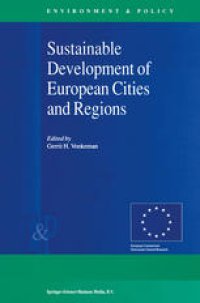
Ebook: Sustainable Development of European Cities and Regions
- Tags: Environmental Management, Regional/Spatial Science
- Series: Environment & Policy 26
- Year: 2000
- Publisher: Springer Netherlands
- Edition: 1
- Language: English
- pdf
Sustainable development has been the basic goal of the European Union since the Treaty of Amsterdam. After an in-depth analysis of the concept, the book goes on to translate the concept into practicable and tangible opportunities for urban and regional sustainable development. Extensive lists of criteria and indicators have been developed for additional explanation and support. An entirely new and innovative system for sustainability planning is presented, based on the interdependence of the cities and their `hinterlands' and on the conviction that the development of one or more key sectors usually has a better potential for success than striving for overall sustainability planning right from the start.
Although the approach itself is fundamental, it has been guided throughout by practical applicability and realism. It has been tested in case studies in a number of European regions, with agriculture and forestry, small and medium sized industries, and tourism as key sectors. Detailed guidelines are given on how to apply the methodology in practice, how to embed existing practices within it, and how to manage the indispensable stakeholder participation. The chapter on European Union policies, activities and possible sources of funding completes the work.
Readership: Required reading for all those involved in urban and regional sustainable development.
Sustainable development has been the basic goal of the European Union since the Treaty of Amsterdam. After an in-depth analysis of the concept, the book goes on to translate the concept into practicable and tangible opportunities for urban and regional sustainable development. Extensive lists of criteria and indicators have been developed for additional explanation and support. An entirely new and innovative system for sustainability planning is presented, based on the interdependence of the cities and their `hinterlands' and on the conviction that the development of one or more key sectors usually has a better potential for success than striving for overall sustainability planning right from the start.
Although the approach itself is fundamental, it has been guided throughout by practical applicability and realism. It has been tested in case studies in a number of European regions, with agriculture and forestry, small and medium sized industries, and tourism as key sectors. Detailed guidelines are given on how to apply the methodology in practice, how to embed existing practices within it, and how to manage the indispensable stakeholder participation. The chapter on European Union policies, activities and possible sources of funding completes the work.
Readership: Required reading for all those involved in urban and regional sustainable development.